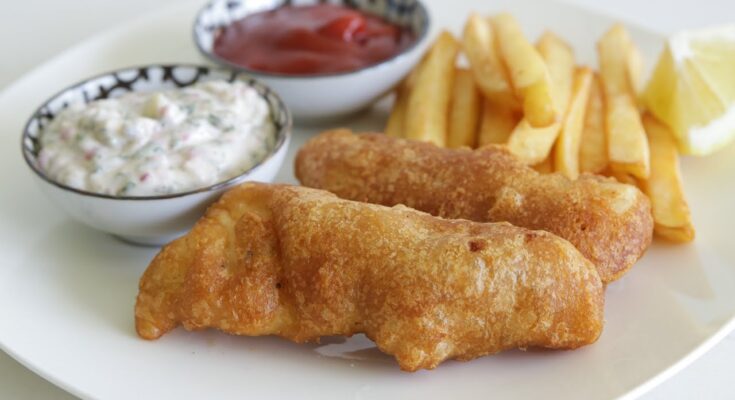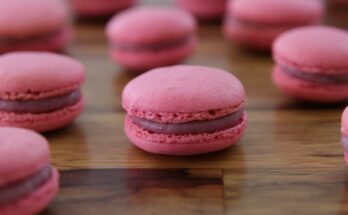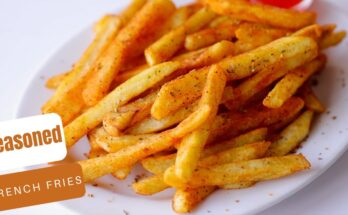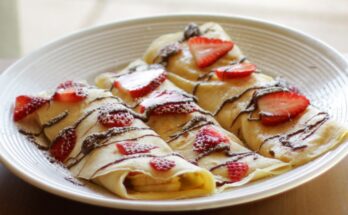Fish and Chip Recipe: Fish and chips are more than just a meal—they’re a culinary tradition. From the bustling streets of London to cozy kitchens around the world, this dish has stood the test of time as one of the most comforting and satisfying meals ever created. If you’ve ever wondered how to recreate that crispy golden fish paired with perfectly fried chips at home, you’re in the right place. This guide will take you through everything step by step, ensuring you get the authentic taste right from your own kitchen.
Introduction to the Classic Fish and Chips
When you think of British cuisine, fish and chips is usually the first dish that comes to mind. This simple yet flavorful meal first became popular in the 19th century. Street vendors would wrap it in newspaper and serve it hot, making it the ultimate takeaway food. It was cheap, filling, and delicious—perfect for working-class families.
Over time, it became more than just a cheap meal. Today, fish and chips symbolize comfort, nostalgia, and togetherness. Imagine sitting by the seaside with a hot, crispy portion of fish and chips wrapped in paper—that’s the true British experience!
But what makes it so irresistible? The magic lies in the contrast: the crunchy, golden batter hugging tender, flaky fish paired with thick, fluffy-on-the-inside yet crispy-on-the-outside chips. Add some tartar sauce, mushy peas, or just a sprinkle of salt and vinegar, and you’ve got perfection on a plate.
Making it at home gives you complete control—you can choose the freshest fish, the crispiest batter, and adjust flavors to your liking. Whether you want the traditional deep-fried version or a lighter baked one, this recipe will walk you through it all.
Ingredients You’ll Need
Before diving into the cooking process, it’s important to gather all your ingredients. Think of this step as setting the stage for success. Fish and chips may look simple, but each ingredient plays a crucial role in getting that authentic taste and texture.
For the Fish:
- 4 white fish fillets (cod, haddock, or pollock are great choices)
- 1 cup all-purpose flour (for dredging)
- 1 cup all-purpose flour (for batter)
- 1 cup cold beer or sparkling water (for batter)
- 1 teaspoon baking powder
- 1 teaspoon salt
- ½ teaspoon black pepper
For the Chips (Fries):
- 4 large potatoes (Maris Piper, Russet, or King Edward work best)
- 2-3 tablespoons vegetable oil (for coating before frying)
- Salt, to taste
For Frying:
- 4-5 cups vegetable oil (canola, sunflower, or peanut oil)
Optional Extras:
- Tartar sauce
- Lemon wedges
- Malt vinegar
- Mushy peas
- Pickled onions or gherkins
Every ingredient here has a purpose. The fish should be mild and flaky, the flour helps the batter stick, and the cold beer or sparkling water gives the batter its light, airy crunch. The potatoes you pick also matter—starchy ones make the best chips.
Choosing the Right Fish
The type of fish you choose can make or break your dish. Traditionally, cod and haddock are the stars of British fish and chips. Cod has a mild, slightly sweet flavor with large, tender flakes, while haddock is firmer with a subtle briny taste.
If you can’t find cod or haddock, don’t worry—there are plenty of alternatives. Pollock, halibut, sole, or even tilapia can work. The key is to use a white, flaky fish that isn’t too oily.
Fresh vs. Frozen Fish
Fresh fish is always ideal, but frozen fillets can be just as good if you thaw them properly. Make sure to pat them completely dry before coating them with flour and batter, otherwise, excess moisture will make the coating soggy.
Preparing the Fish
- Remove any bones with tweezers.
- Pat dry with paper towels to ensure the batter sticks.
- Cut into even portions so they cook at the same rate.
By choosing the right fish and preparing it properly, you’re setting the foundation for perfectly crispy, golden fillets that stay moist inside.
Preparing the Perfect Batter
The batter is what sets fish and chips apart from other fried dishes. A good batter should be light, airy, and crispy—not greasy or heavy.
Traditional Beer Batter Recipe
Beer is the secret ingredient in traditional fish and chip batter. The carbonation helps create a light, crunchy coating. Plus, it adds a subtle depth of flavor. Here’s how to make it:
- In a bowl, mix 1 cup flour, 1 teaspoon baking powder, 1 teaspoon salt, and ½ teaspoon black pepper.
- Slowly whisk in 1 cup of cold beer until smooth.
- Keep the batter cold until you’re ready to fry—it helps the coating crisp up.
Non-Alcoholic Alternative
If you don’t want to use beer, cold sparkling water is an excellent substitute. The bubbles work the same way, making the batter airy and crisp.
Tips for Success
- Always keep the batter cold. You can even chill the flour before mixing.
- Don’t overmix—tiny lumps are fine.
- Dip the fish in flour first, then in the batter. This helps it stick.
When fried, the batter puffs up into a golden shell, locking in the fish’s natural juices. Every bite gives you that satisfying crunch followed by tender, melt-in-your-mouth fish.
Making the Chips (Fries) from Scratch
Chips are just as important as the fish. The perfect chip is crispy on the outside and fluffy on the inside, and getting it right requires a little technique.
Choosing the Right Potatoes
Go for starchy varieties like Maris Piper, King Edward, or Russet potatoes. These have less water, which makes them fry up crispier. Avoid waxy potatoes as they tend to stay firm and won’t give you that soft, fluffy center.
Cutting the Chips
- For traditional fish and chips, cut the potatoes into thick slices—about 1cm thick.
- For a modern twist, you can go thinner, but thick-cut is the classic style.
The Double-Frying Method
This is the secret to restaurant-quality chips:
- First Fry (Blanching): Fry at 300°F (150°C) until the chips are soft but not browned. Remove and drain.
- Second Fry (Crisping): Increase oil temperature to 375°F (190°C) and fry until golden and crispy.
Seasoning the Chips
As soon as they come out of the fryer, sprinkle them with salt. The heat helps the seasoning stick better. For extra flavor, you can add garlic salt, paprika, or even a drizzle of malt vinegar.
Homemade chips take a little more effort, but they’re worth it. Once you bite into that crunchy outside and fluffy inside, you’ll never want store-bought fries again.
Step-by-Step Guide to Cooking Fish and Chips
Now that you’ve prepared your batter and chips, it’s time to bring it all together. Cooking fish and chips might sound intimidating at first, but once you understand the timing and temperatures, it becomes second nature.
Frying the Chips First
Always start with the chips because they take longer to cook than fish. Follow the double-fry method for best results:
- Heat your oil to 300°F (150°C).
- Fry the cut potatoes for about 5–6 minutes until they are soft but pale in color.
- Remove them and let them rest on a paper towel while you prepare the fish.
- Just before serving, return them to oil heated at 375°F (190°C) for a second fry until golden brown.
Frying the Fish
- Heat your oil to 350°F (175°C).
- Dredge each fillet in flour first, shaking off excess.
- Dip into your cold batter, ensuring it’s fully coated.
- Carefully lower the fillet into the hot oil.
- Fry for 4–6 minutes, turning once, until golden and crispy.
The fish should be beautifully golden on the outside while still tender and flaky inside.
Timing and Temperature Control
- Don’t overcrowd the pan. Frying too many pieces at once lowers the oil temperature, leading to soggy food.
- Use a thermometer. Guessing the oil’s heat is risky; precision ensures consistency.
- Drain properly. Place cooked fish and chips on a wire rack or paper towels to remove excess oil.
Cooking is all about rhythm—chips go in first, followed by the fish, then chips get their second fry right before serving. Done correctly, everything comes together piping hot and crispy at the same time.
Essential Tools and Equipment
You don’t need a fancy commercial kitchen to make excellent fish and chips. With the right tools, you can get professional results at home.
Deep Fryer vs. Heavy Pot
- Deep fryer: Offers built-in temperature control, making frying easier.
- Heavy pot or Dutch oven: Works just as well if you use a thermometer and monitor the heat.
Thermometer Importance
A kitchen thermometer is your best friend here. Too cold, and your fish absorbs oil and turns greasy. Too hot, and the outside burns before the inside cooks. Keeping the oil between 350–375°F (175–190°C) is key.
Utensils for Frying Safely
- Tongs: For turning fish without damaging the batter.
- Spider strainer or slotted spoon: To remove chips and fish quickly.
- Wire rack: Keeps fried items crisp by allowing air circulation underneath.
Other Handy Tools
- Sharp knife for cutting potatoes evenly.
- Mixing bowls for batter preparation.
- Paper towels to absorb excess oil.
Equipping your kitchen properly makes the process smoother and ensures that you get restaurant-quality fish and chips every time.
Serving Your Fish and Chips
The way you serve fish and chips can elevate the experience from simple homemade food to a restaurant-worthy meal.
Traditional Presentation
The classic way? Wrapped in paper—originally newspaper, though nowadays it’s waxed food-safe paper. Serve it hot and casual, just like at a seaside takeaway.
Classic Accompaniments
- Mushy peas: A British staple, adding a creamy, savory balance.
- Tartar sauce: The tangy, creamy dip that complements crispy fish.
- Malt vinegar: A sharp, acidic splash that cuts through the richness.
- Pickled onions or gherkins: Add a refreshing bite.
Modern Plating Ideas
If you want to impress, serve on a wooden board or plate with small ramekins of sauce and lemon wedges. You can even toss chips with herbs like rosemary or parmesan for a gourmet twist.
No matter how you serve it, fish and chips are meant to be shared—so pile it high and dig in while it’s hot.
Tips for Healthier Fish and Chips
Love the taste but worried about calories? Don’t worry—there are plenty of ways to make fish and chips lighter without losing too much of that indulgent crunch.
Baking Instead of Frying
- Coat your fish in panko breadcrumbs instead of batter.
- Bake at 425°F (220°C) for 20 minutes until golden.
- For chips, toss in a small amount of oil and bake until crispy.
Air Fryer Alternatives
Air fryers can give surprisingly crispy results with far less oil. Fish fillets coated in a light batter or breadcrumbs cook beautifully in about 10–12 minutes. Chips also turn out golden with just a tablespoon of oil.
Health-Conscious Oil Choices
Use oils with a high smoke point and healthy fats, such as canola, sunflower, or avocado oil. Avoid reusing oil multiple times, as it breaks down and becomes less healthy.
By tweaking just a few steps, you can enjoy fish and chips more often without the guilt. It’s proof that comfort food doesn’t always have to be unhealthy.
Common Mistakes to Avoid
Even though fish and chips seem simple, a few mistakes can ruin the dish. Here’s how to avoid them:
1. Overcrowding the Pan
Adding too much fish or too many chips at once drops the oil temperature. Result? Soggy, oily food instead of crispy golden perfection. Fry in small batches.
2. Wrong Oil Temperature
If your oil is too hot, the batter burns before the fish cooks. Too cold, and the coating absorbs oil. Always keep it between 350–375°F (175–190°C).
3. Batter Slipping Off the Fish
This usually happens when the fish is too wet. Always pat the fillets completely dry and dredge in flour before dipping them in batter.
4. Not Resting the Chips
Skipping the first fry or not resting the potatoes makes chips limp instead of fluffy inside. Double-frying is non-negotiable for authentic texture.
5. Using the Wrong Potatoes
Choosing waxy potatoes leads to firm, dense fries. Stick with starchy varieties for the best results.
Avoid these pitfalls, and you’ll have a foolproof fish and chips recipe you can rely on every time.
Variations of Fish and Chips Around the World
While fish and chips originated in the UK, this iconic dish has traveled across the globe and taken on exciting regional twists. Let’s explore how different cultures have reimagined this classic.
British Traditional Version
The classic UK version is made with cod or haddock, deep-fried in beer batter, and served with thick-cut chips. Accompaniments include mushy peas, malt vinegar, and tartar sauce. It’s hearty, simple, and comforting.
American-Style Fish and Fries
In the U.S., fish and chips often come with thinner fries (closer to French fries) and are paired with coleslaw instead of mushy peas. Catfish and pollock are popular fish choices, especially in the southern states.
Asian-Inspired Versions
In Japan, tempura-style fish with lighter batter is common. In India, you might find spiced fish fillets fried in gram flour batter, paired with masala fries. In Australia and New Zealand, fish and chips often feature snapper, hoki, or barramundi, served with aioli or tomato sauce.
Mediterranean Twist
Some Mediterranean countries fry fish with olive oil and serve it alongside seasoned potato wedges, fresh lemon, and herb-based sauces.
Each variation highlights the versatility of this dish. Whether it’s rich and traditional or light and spiced, fish and chips adapt beautifully to different culinary cultures.
Storing and Reheating Leftovers
Fish and chips taste best when eaten fresh, but sometimes you’ll have leftovers. Knowing how to store and reheat them properly keeps them crispy instead of soggy.
Storing Leftovers
- Fish: Place cooled fillets in an airtight container lined with paper towels to absorb excess oil. Store in the fridge for up to 2 days.
- Chips: Store separately in another airtight container. They tend to lose their crunch quickly, so consume them within 1–2 days.
Reheating Fish
- Oven method (best): Preheat oven to 375°F (190°C). Place fish on a wire rack over a baking sheet and heat for 10–12 minutes. This keeps it crisp.
- Air fryer method: Heat at 350°F (175°C) for about 6–8 minutes.
- Avoid microwaving, as it makes the batter soggy.
Reheating Chips
- Oven method: Spread on a baking tray and bake at 400°F (200°C) for 10–12 minutes.
- Air fryer method: Toss them in for about 5 minutes at 375°F.
Reheating properly ensures your leftovers taste nearly as good as when freshly made.
Pairing Drinks with Fish and Chips
The right drink can transform fish and chips from a simple meal into a memorable dining experience. Whether you prefer something refreshing, bold, or alcohol-free, there are plenty of options.
Best Beers to Serve
- Lager: Crisp and clean, balances the richness.
- Pale Ale: Slight bitterness complements fried food.
- Stout or Porter: Adds a deep, malty contrast to crispy fish.
Wine Pairings
- Sauvignon Blanc: Bright acidity cuts through the batter.
- Chardonnay (unoaked): Light and refreshing.
- Sparkling wine: The bubbles enhance the crispy texture.
Non-Alcoholic Options
- Sparkling water with lemon: Refreshing and palate-cleansing.
- Ginger ale: Sweet and spicy, pairs well with fried food.
- Iced tea with lemon: Light and crisp, balancing the heaviness of fried dishes.
Choosing the right pairing elevates your meal from casual to gourmet without much effort.
Nutritional Breakdown of Fish and Chips
Fish and chips are indulgent, but it helps to know what’s in your plate—especially if you’re watching your diet.
Average Nutritional Values (per serving)
- Fish fillet (fried): 400–500 calories, 20g protein, 25g fat
- Chips (1 portion): 300–400 calories, 10g fat, 60g carbs
- Total: Around 700–900 calories per serving
Ways to Make It Lighter
- Use an air fryer instead of deep-frying.
- Bake instead of frying for chips.
- Opt for leaner fish like cod or pollock.
- Swap tartar sauce for a lighter yogurt-based dip.
Nutritional Benefits
Despite its indulgence, fish and chips can offer some benefits:
- Fish is high in protein and rich in omega-3 fatty acids, which are good for heart health.
- Potatoes provide fiber and essential minerals.
With a few adjustments, you can enjoy this classic dish without compromising too much on health.
FAQs about Fish and Chip Recipe
1. Can I use frozen fish for fish and chips?
Yes, you can. Just thaw it completely and pat dry with paper towels before battering to avoid soggy results.
2. What oil is best for frying fish and chips?
Canola, sunflower, or peanut oil are excellent choices due to their high smoke points and neutral flavors.
3. Can I make fish and chips gluten-free?
Absolutely! Use gluten-free flour for the batter and ensure your frying oil hasn’t been contaminated with gluten products.
4. How do I make my fish and chips crispier?
Keep the batter cold, fry at the right temperature, and avoid overcrowding the pan. Double-frying the chips is also essential.
5. Can I make fish and chips ahead of time?
You can prepare the batter and cut the potatoes in advance, but frying should be done right before serving for the crispiest results.
Conclusion
Fish and chips are more than just a meal—they’re a cultural icon. From their humble beginnings in the UK to becoming a beloved dish worldwide, they continue to bring people comfort and joy. Making them at home may take a little effort, but the reward is unbeatable: crispy golden fish, fluffy yet crunchy chips, and the satisfaction of enjoying a freshly made classic.
With this step-by-step guide, you now know how to select the right fish, prepare the perfect batter, double-fry your chips, and serve everything like a pro. Whether you stick to the traditional version or experiment with healthier alternatives, one thing’s for sure—fish and chips will always remain a timeless favorite.
So, roll up your sleeves, heat up that oil, and bring the taste of the seaside right to your kitchen table.



